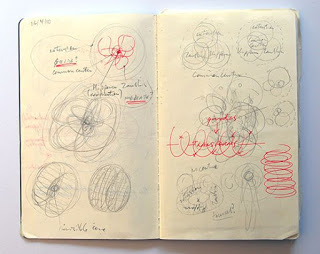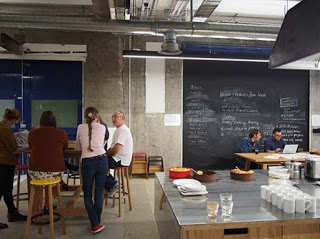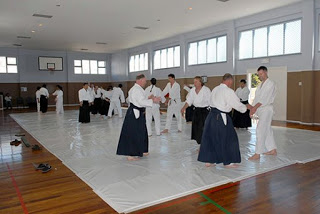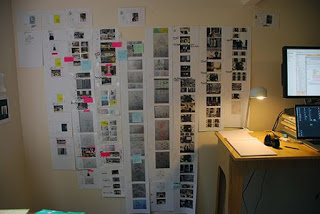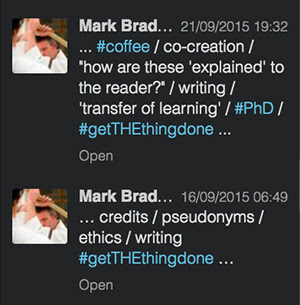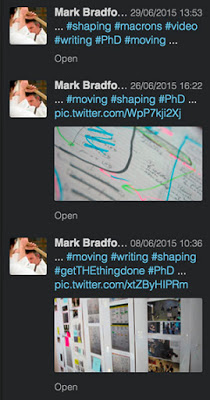I am Mark Bradford and This is How I Work
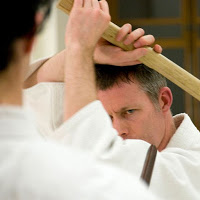 Today, I am hosting Mark Bradford in the “How I Work” series. Mark is a designer exploring leadership within creative practice through both theoretical and applied design research. He just passed his PhD(Business) in February this year. His thesis titled ‘BeWeDō®: Co-creating Possibilities with Movement,’ investigated how Aikidō movement practices facilitate leadership development for co-creation. He is currently responsible for lecturing and coordinating senior studio/theory courses within the School of Design at the College of Creative Arts in Wellington, New Zealand.
Today, I am hosting Mark Bradford in the “How I Work” series. Mark is a designer exploring leadership within creative practice through both theoretical and applied design research. He just passed his PhD(Business) in February this year. His thesis titled ‘BeWeDō®: Co-creating Possibilities with Movement,’ investigated how Aikidō movement practices facilitate leadership development for co-creation. He is currently responsible for lecturing and coordinating senior studio/theory courses within the School of Design at the College of Creative Arts in Wellington, New Zealand.
Current Job: Senior Lecturer, School of Design, Massey University.
Current Location: Wellington, New Zealand.
Current mobile device: Alcatel One Touch.
Current computer: Apple MacBook Pro 15-inch.
Can you briefly explain your current situation and research to us?
I just passed my PhD recently! My interdisciplinary research focused on investigating how the movement practices of the Japanese martial art of Aikidō can facilitate leadership development for co-creation. The research synthesised diverse literatures focussed on aikidoka, leadership development, and creative modes of practice as processes in action and in relation to collective creativity and the context of co-creation within the experience economy.
What tools, apps and software are essential to your workflow?
My design-led ethnography combines autoethnography and visual ethnography. This approach involves a wide range of interconnected design drawing-acts to document my research such as conceptualising, sketching, mindmapping, conceptmapping, writing, diagramming, photography, and video during the fieldwork.
The fieldnotes were systematically coded utilising Microsoft Excel (to look for conceptual patterns during the processes of coding), Inspiration (a visual learning tool I found invaluable for organising, grouping, and analyzing textual and image-based drawing data diagrammatically), Google documents, as well as working manually – writing and drawing by hand (using Moleskin journals) – to respond to and follow lines of inquiry emerging in the field. The combination of computer software and manual line-making focused the data analysis and connected the processes of self-reflexivity. From a writing perspective I used Microsoft Word + Endnote referencing software. The final thesis was designed using Adobe InDesign & Photoshop.
What does your workspace setup look like?
At the School of Design I work in a fantastic large open plan workspace with many different types of flexible working spaces. I have no one specific workspace – I tend to roam the space and choose a location that suits the type of work (conversational, organisational, academic etc) I intend doing on the day.
For my ethnographic research, my workspace was in multiple fields. The majority of this involved training in the Aikidō Tenshindo dōjō in Wellington, as well at times in Aikidō Shinryukan dōjō’s throughout New Zealand.
From a PhD writing perspective I worked from my home office. For the last 18 months this has all been done at a standing desk which has been fantastic! I found it impossible to write in the work environment. I like my home office to be clean/sparse, but welcome the creative chaos the writing/visualising process often generates.
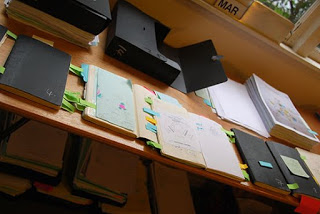
What is your best advice for productive academic work?
This is a tricky question . . . I’ve got plenty of tips if you’re interested in being unproductive! Luckily by the end of the PhD I’ve certainly got more productive . . . incredibly focussed. It was exciting! I did this in private, public, and more philosophical ways . . . the key in my opinion is slowly finding YOUR WAY (no matter how crazy it may sound or appear to others!) to approach what is an incredible challenging task.
Pragmatically I’d use Apple Calendars (iCal) to schedule weekly and organise the day-to-day tasks. Each research day meant working out a plan using a mix of iCal, lists and diagrams (hand drawn), scattered Post-its, using ‘Timey’ (a basic timer that goes on your computer menu bar), and using social media (Twitter – especially Tweetdeck for Chrome) to help me work: I stand at my desk and work for 30+30+30 minutes without distraction. Then, after the 90 minutes are up, I do something completely unrelated for 15 minutes. After this time is up I go back to my desk and repeat.
Privately, every Saturday morning (always bolstered with black coffee = a positive ritual), I’d plan my research week ahead inspired by a Tweet by Tom Peters (@tom_peters) “Sunday task: Leadership is theater: “Script” your 1st 10 “plays” for Monday morning” (I adapted this idea => ‘script 3 plays for the week’ > hang these “commitments” on the wall next to where I was working).
Another Tweet was influential from @jasonfried: “I never liked ‘get things done.’ Get THE thing done not thingS. To know what isn’t worth doing is key.” – via @johnmaeda.” I used this more motivationally => generated the Twitter hashtag #getTHEthingdone > tweeted these (often obscure) “commitments” publically!
More philosophically, I’ve transferred a few of the key Aikidō metaphors I’ve overheard my instructor use on-the-mat. Sensei Richard Halson (5th Dan) would often offer pragmatic reminders – mainly to new aikidoka (a practitioner of Aikidō) – using numbering systems such as “Aikidō 101” (meaning offline or don’t be there), “Aikidō 102” (meaning breathe), and “Aikidō 103” (meaning relax). I’d often find myself applying these principles in a variety of ways in relation to my academic research off-the-mat. For example, the flowing movement practices of Aikidō were eluded to in a more playful way via social media => using the Twitter hashtag’s #move #moving #movement > public tweets that were for me more collegial/cultural/cryptic and communicated to people who knew my projects trajectory.
Lastly, you have to be pretty selfish. Find a space where you can get away from everything/everyone and keep things simple. For me this ranged from disappearing downstairs to my home office (which my sensitive teenage daughter sometimes referred to as “loserville”!) through to taking a walk at my local beach to ‘clear my head’ => Relax, then #move!
How do you keep an overview of projects and tasks?
The more pragmatic day-to-day tasks were organised using a combination of daily lists and iCal. The overall schedule (with key milestones) was organised using Google spreadsheet.
Besides phone and computer, do you use other technological tools in work and daily life?
The pencil was THE key ‘technological tool’ I used. During the fieldwork, I also used photography (Nikon D60 digital camera), video (GoPro) and digital voice recorders (Olympus DS-50).
Which skill makes you stand out as an academic?
Relentless curiosity.
What do you listen to when you work?
I find music too distracting when writing. If I do introduce music I tend to seek rhythmic sounds and avoid music with vocals to encourage reflexivity i.e. minimalist composers such as Philip Glass. At other times during my research/writing process (when organising, sketching, mindmapping, conceptmapping, diagramming, designing the thesis layout) music was used motivationally – often as a way too loudly celebrate breaking away from a long period of silent writing i.e. The Fall, Black Flag, Atoms for Peace…
What are you currently reading? How do you find time for reading?
I just read ‘The Future’ by Marc Augé; ‘The World Beyond Your Head: On Becoming an Individual in an Age of Distraction’ by Matthew Crawford; and flicking through ‘Camper: The Walking Society’ by Anniina Koivu (Ed). When I was in the thick of thesis writing I tried to “read” something completely different than what the research required at the end of the day i.e. books on artists which were more visual and a useful distraction and subtle creative provocation.
Are you more of an introvert or extrovert? How does this influence your working habits?
Introvert (that would explain why I developed a habit of writing in a hoodie!).
What’s your sleep routine like?
Pragmatic! Historically I’ve always been a ‘morning person’ . . . but at times in the last few years this habit has needed to be more flexible and fit in with the different kinds of demands the PhD process brings + my body clearly signals when it’s stopped thinking late at night and essentially signals “go get some sleep stupid!”
What’s the best advice you ever received?
I’m not sure it’s necessarily the “best advice” . . . but I often find myself returning to Aukje Thomassen’s encouraging words: “Dare to think openly and creatively.”

